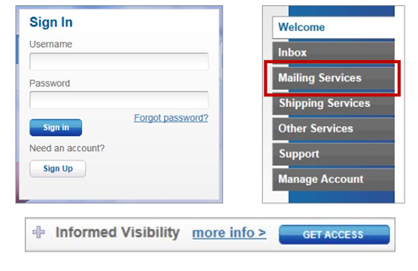Now that the USPS has made Seamless Acceptance mandatory, mailers are more closely monitoring their Mailer Scorecard data to pinpoint areas where errors are occurring. But how do mailers access the details of the reported errors? Using the Informed Visibility Mail Tracking & Reporting (IV-MTR) Mail Quality Data is the fastest, easiest way to gain access to this detailed information. Detailed error data from the Mailer Scorecard is available for Full-Service, Move Update, eInduction, and Seamless Acceptance.
Accessing the Data

|
Your BSA will then need to contact the IV-MTR Help Desk to request the BSA authorization code. When input, this will successfully set up the CRID in the application.

|
Establishing Data Feeds
Once you have received access to the data, you can set up a data feed to receive the detailed data on a periodic basis, such as daily, weekly, and/or monthly. These feeds may be customized by selecting the file format, delivery location, frequency, CRID and Mailer Role, Program and Error Types, and specific data fields desired. These feeds may be modified as needed. It is important to note that downloads are available from the IV-MTR application for only seven days, so it is important that mailers create a process for accessing this data on a routine basis so that the data is available when you need it.
Why This Data Is Important
You may think this is all a lot of work to get set up and would prefer not to bother with it. However, this detailed data is precisely what you will need in cases where you receive assessments from the USPS, such as for Seamless Acceptance errors. This is especially true for undocumented mail piece errors. It is critical for mail preparers to regularly download and store this data in tables that will allow you easy access to the necessary data to research and/or dispute these assessments. Don’t procrastinate on this — a big assessment from the USPS without any means to research or dispute it can be crippling for your operation.
Resources
The USPS has a number of resources available for mailers wishing to access this data. There is a Mail Quality Data Fact Sheet (https://postalpro.usps.com/mailing/mqd/fact_sheet), Frequently Asked Questions (FAQs) (https://postalpro.usps.com/mailing/mqd/faqs), instructions on Provisioning Mail Quality Data (https://postalpro.usps.com/mailing/mqd/instructions), and a listing of Error Codes (https://postalpro.usps.com/mqd/error_codes). For more information on Informed Visibility in general, access the dedicated landing page (https://postalpro.usps.com/informedvisibility) on the USPS PostalPro website.
Jeff Peoples is founder, president, and CEO at Window Book. With over 30 years of innovative postal solutions that make using the Postal Service easier and more profitable for mailers and shippers, he has done presentations at industry events, GraphExpo, MAILCOM, the National Postal Forum, Postal Customer Council meetings, Harvard Business Expert Forum, and other industry and direct marketing events.
This article originally appeared in the November/December, 2020 issue of Mailing Systems Technology.










